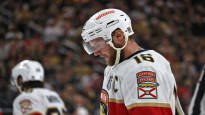The NHL needs growth, but at the same time it hides its star players behind the scenes, writes Urheilu’s NHL editor Tommi Seppälä.
shows the NHL finals live on its channels. The next fight can be seen on Tuesday morning at 03 Finnish time on TV2 and Areena.
LAS VEGAS. The NHL’s media practices changed significantly due to the corona pandemic and the media was no longer allowed in the team’s locker rooms.
Before, reporters could walk straight into the booth after morning practices and matches and talk to the players they needed.
During the pandemic, instead of a free choice, there were a couple of players and a coach in a shared media space.
The situation instantly turned into a nightmare for the media: everyone was offered the same interviews and the same statements.
I spent almost ten years as a correspondent in Vancouver, Canada, and I noticed a coming change even before the corona virus. It was increasingly difficult to reach the home team’s players before and after the matches. When the locker room doors opened, the players had run away, out of reach of the media.
The players were finally brought to the large media group to be sprinkled one by one. In this way, the club’s PR machinery was able to both limit the media obligations of the players and closely monitor what was being talked about at any given time.
Because of this, Canadian colleagues envied the signatory. The Finnish language offered an escape from the limitations of the NHL.
Vegas took the first final 5–2. Watch the highlights of the match:
With the Finnish players who mostly handled their media responsibilities brilliantly, I was able to speak a language that others did not understand. So I got my own stuff, so to speak.
It’s not always enough to speak Finnish either, because the NHL has continued to tighten the lines after the corona. Of course, the dressing rooms have been opened again in many places, but at the same time media activities are severely restricted.
Some NHL clubs handle their media obligations impeccably, even excellently, but some care little about the needs of the media. An example of this was given after the first final match of this year.
One would have imagined that Florida’s captain Alexander Barkov and the star player who flew out of the match Matthew Tkachuk would have been given interviews. Fat chance.
The same thing happened on Sunday during the half-day training. In the NHL’s media practices, the idea that the players of the losing team do not speak is living more and more strongly.
Instead, Florida offered, among other things Zac Dalpen and by Ryan Lomberg – two quadruple chain scramblers. They talked to the media about the top department Sam Reinhart mixed Anthony Duclair. With all due respect, these were not the players the media wanted.
After his own voluntary practice, Vegas opened the doors to his locker room. There were also first-team players.
Players also have responsibilities
The bigger the paycheck, the more players are protected from the media. It is wrong.
Players who earn huge amounts of money playing hockey also have responsibilities, not just rights.
The NHL has also strictly outlined in its rules how players must be available to the media. The dressing rooms must be opened quickly after the match and the playing players must be available.
An exception can be made, for example, by injury. Some of the clubs and even the league itself slip by the rules repeatedly.
For few players, media moments are a pleasure, so the reason is more in the system than in the players. I have been in situations numerous times and heard of situations where a player would speak, but the club prevents it.
It is unbelievable that hockey, which is still completely marginalized globally, can afford such a thing. The action is arrogant and harmful to growth.
Four wins are required for the championship.
4.6. Vegas-Florida 5-2
6.6. at 03:00 Vegas – Florida
9.6. at 03:00 Florida – Vegas
11.6. at 03:00 Florida – Vegas
14.6. at 03.00 Vegas – Florida*
17.6. at 03.00 Florida – Vegas*
20.6. at 03.00 Vegas – Florida*
* If necessary
All matches live on TV2, Areena and the app.
The current playoff series is almost a disaster for the NHL in terms of visibility and media attention. Florida and Vegas are not hockey villages, and the Panthers and Golden Knights as clubs gather huge crowds in front of the televisions.
On top of everything, why is the life of the media working in the finals made difficult?
The NHL needs growth, but at the same time it hides its star players behind the scenes.
The NHL talks nice about the media, but in reality it seems to wish that reporters would watch the games in their broadcasts.
The wish is coming true, because there are fewer journalists in the finals than in living memory, perhaps ever. A large part of these are also the league’s own journalists.
It’s okay to ask, whose interest is driven by the trend at hand?
You can discuss the topic until Tuesday evening, June 6. until 11 p.m. Tunnus is required for commenting.
You can use the form below to send your questions to expert Ismo Lehkonen on ‘s NHL broadcasts. Sending a reply requires a ID.
